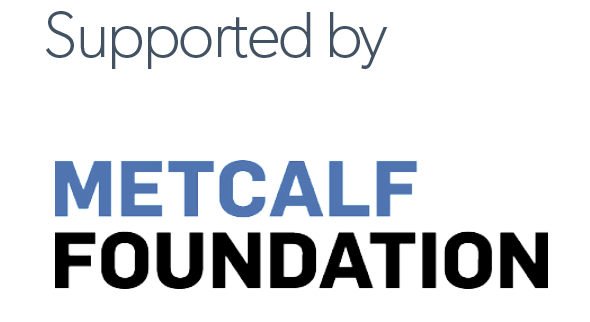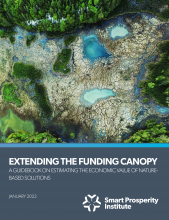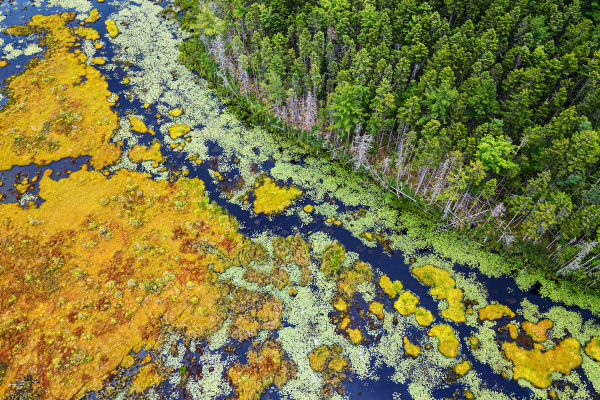Investing in conservation and restoration of nature and in sustainable resource management should be central components of a resilient economic recovery. These investments create economic value and jobs and are critical to meeting Canada’s climate change and biodiversity objectives. However, there are barriers to public and private financing of these projects which mean that they receive less financing than would be justified by their potential economic contributions, not to mention their environmental and social benefits. One such barrier is the fact that practitioners proposing projects that offer nature-based solutions (NBS) to problems like climate change or water management often lack the capacity and data to make an economic case for their projects. This puts them at a disadvantage as they compete for funding with technology-based solutions that tend to have better access to data and familiarity with methods to estimate their project’s impact on revenue streams, cost savings, jobs, and economic output.
This guidebook aims to remove this barrier by helping NBS practitioners make an economic case for NBS projects. We discuss simple, publicly accessible methods for estimating 1) revenue streams and cost savings due to increased ecosystem services, and 2) impacts on local jobs and economic output.
We also discuss ways public data sources could be improved to make it easier to estimate the economic case for NBS. Finally, we make the economic case for four case studies: a wetland restoration project in rural Ontario, a mixed-use forestry and conservation project in British Columbia, a low-tillage potato farming operation on Prince Edward Island, and a protected area in the Northwest Territories.
We find that:
1. NBS projects produce substantial economic benefits, even by our conservative definition which focuses on revenue streams, cost savings, and impacts on jobs and economic output.
2. When estimating revenue and cost savings from enhanced ecosystem services, transferring estimates (aka “value transfer”) from other projects can lead to important errors, despite being common practice. That said, value transfer can be helpful if done carefully. NBS practitioners can avoid major inaccuracies by following a few best practices:
- The revenue and cost savings from ecosystem services depend on site size and surrounding land uses. Adjusting transferred values based on these factors can make estimates more accurate.
- Project impacts on local jobs and economic output depend on the structure of the local economy and on a project’s inputs. It is better to make a crude estimate with project-specific data than to transfer a sophisticated estimate from a different context. If you do transfer an estimate, it is more important to find an estimate from a project in a similar economic context and with similar labour requirements than to find an estimate from a project in a similar ecological context.
3. Government agencies could make it easier to estimate the business case for NBS projects by filling gaps in publicly accessible data sources. For example:
- Statistics Canada’s input-output multipliers, which can be used to estimate project impacts on jobs and economic output, use categories of economic activity that do not correspond well with the typical expenditures of NBS projects.
- Biophysical and economic data that are needed to estimate the value of important ecosystem services are not yet publicly available. For example:
- Federal and provincial governments should support the collection of more data on carbon stocks and fluxes in unmanaged forests and areas with non-forest vegetation, particularly peatlands, and make this data available in an integrated, spatially-explicit format that is accessible to non-expert NBS practitioners. Better data on wetland characteristics would also help NBS practitioners estimate the value of other ecosystem services, like nutrient removal.
- Treatment plants that remove nutrients like phosphorus and nitrogen from runoff and wastewater should make their unit removal costs public. This would allow NBS practitioners (and, ideally, municipal asset planners) to estimate the value of NBS projects that can remove these nutrients.
- More up-to-date, region-specific data is needed on the cost to farmers of soil erosion.
- The 2012 Canadian Nature Survey provides useful estimates of expenditures on nature-related recreation and tourism, but these estimates are now out of date, and they are not regionally specific.
- Federal and provincial governments should support the collection of more data on carbon stocks and fluxes in unmanaged forests and areas with non-forest vegetation, particularly peatlands, and make this data available in an integrated, spatially-explicit format that is accessible to non-expert NBS practitioners. Better data on wetland characteristics would also help NBS practitioners estimate the value of other ecosystem services, like nutrient removal.
Read the report
Learn more - Register now for our free February 10th event “Money doesn’t grow on trees: The complexity of how we value nature” which will explore the nuance and complexity of assigning economic value to nature.






